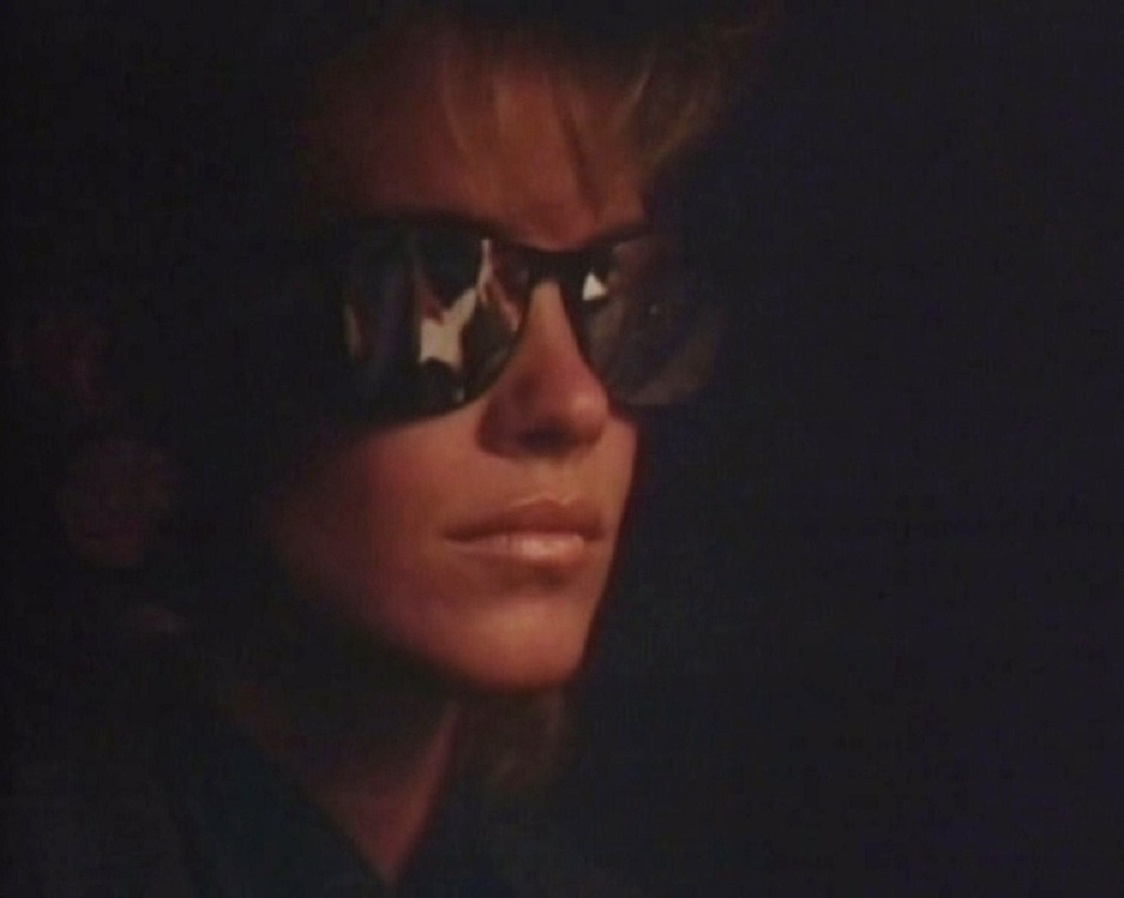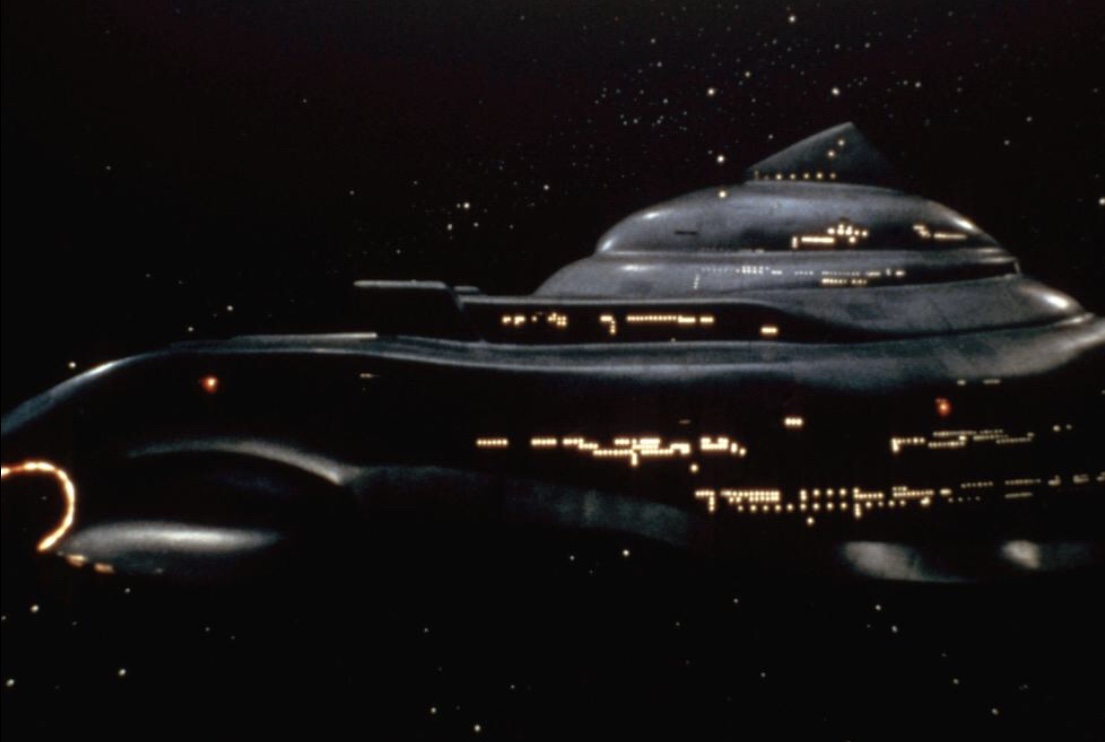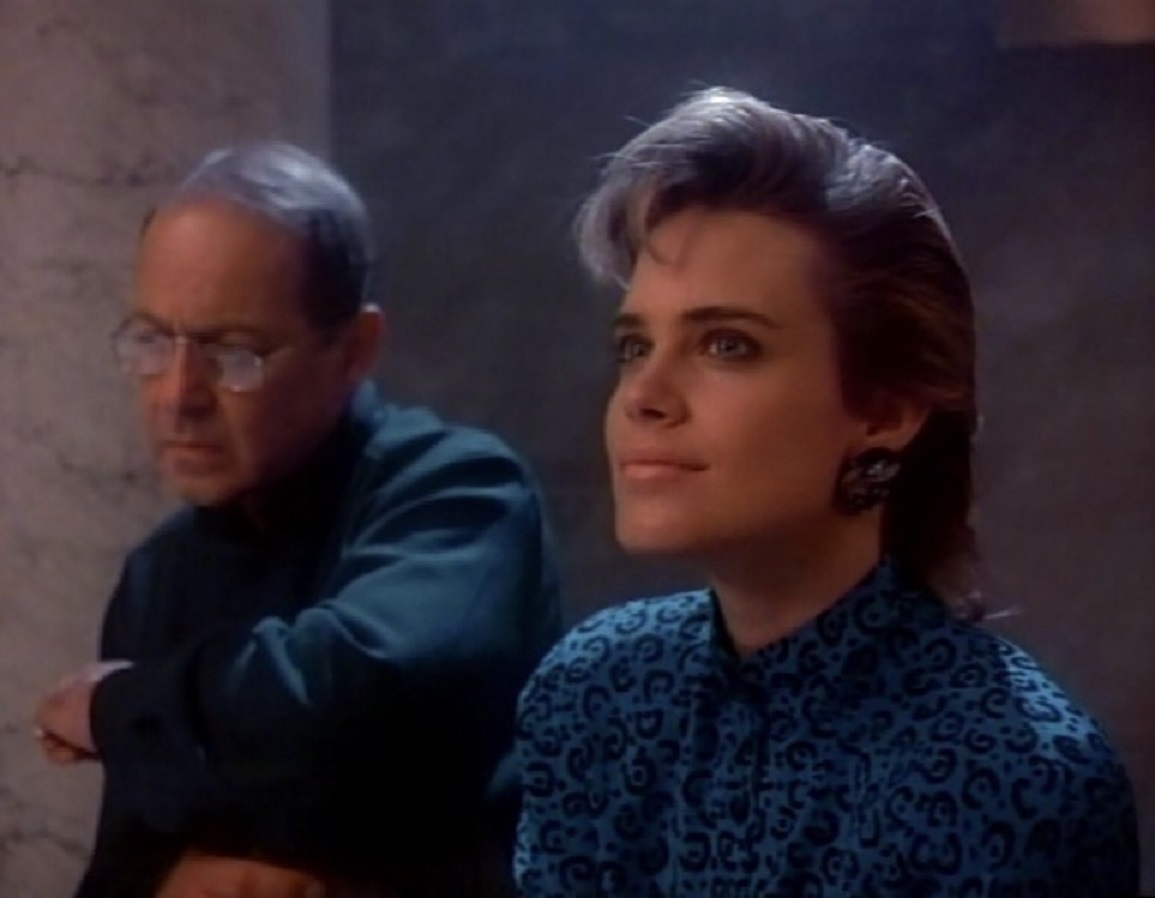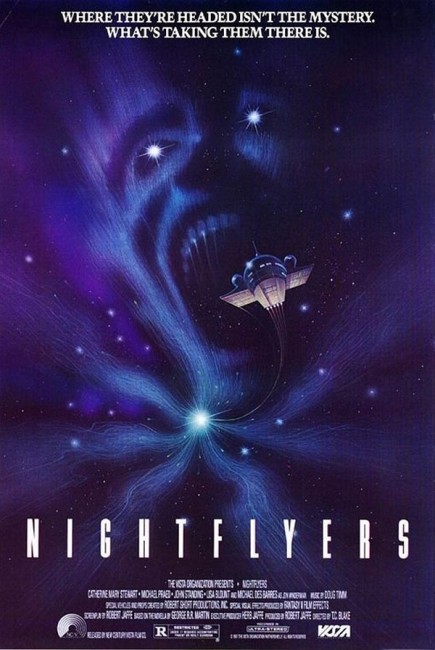Crew
Director – T.C. Blake [Robert Collector], Screenplay/Producer – Robert Jaffe, Based on the Novella Nightflyers (1980) by George R.R. Martin, Photography – Shelly Johnson, Music – Doug Timm, Visual Effects – Fantasy II Film Effects (Supervisor – Gene Warren Jr.), Mechanical/Makeup Effects – Robert Short Productions Inc. (Supervisor – Robert Short), Pyrotechnic Effects – Steve Galich, Roger George & Lisa Romanoff, Makeup Effects – Chris Biggs & Jill Rockow, Production Design – John Muto. Production Company – The Vista Organization.
Cast
Catherine Mary Stewart (Miranda Dorleac), Michael Praed (Captain Royd Erris), John Standing (Michael D’Branin), Michael Des Barres (Jon Winderman), Glenn Withrow (Keelor), James Avery (Darryl Fontaine), Lisa Blount (Audrey Zale), Helene Udy (Lily Cantwill), Annabel Brooks (Eliza Scott)
Plot
A scientific research team headed by Michael D’Branin charter the starship Nightflyer. They are in search of a series of signals believed to belong to The Volkryn, a mythological race of creatures that pass through the galaxy creating new stars in their wake. As the expedition sets out, the project’s co-ordinator Miranda Dorleac is drawn into a strange relationship with Royd Erris, the captain of the entirely automated Nightflyer, who only communicates with them by hologram. Royd reveals to Miranda that he is a clone of his late mother Adara. Having been born in the antiseptic zero gravity environment of space, he is unable to meet with them because the artificial gravity and their germs would kill him. The ship is abruptly taken over by Adara who has had her personality transferred into the ship’s computer banks. Jealous of the thought that Miranda will take Royd away from her, Adara starts using the ship’s equipment to eliminate the team.
Dismissed by most at the time it came out, Nightflyers is a unique science-fiction film – a science-fiction ghost story of sorts. It bottomed out badly at the box-office when it was originally released, was quickly dumped into video release and never appears to have been resurrected in the modern dvd era. It is largely forgotten today where for many years people confused it with the Stephen King adapted vampire film The Night Flier (1997). It is however a film worthy of revaluation. It was certainly one of the more intelligent and overlooked genre items of the late 1980s.
The film is based on Nightflyers (1980), a novella by author George R.R. Martin, known for books like Dying of the Light (1977), Fevre Dream (1982) and the A Song of Fire and Ice series. (The novella gives its title to Nightflyers (1981), George R.R. Martin’s story collection of the same name). In the media, Martin served as a story editor on tv’s Beauty and the Beast (1987-90) and subsequently furnished the books that became the massive hit phenomenon known as tv’s Game of Thrones (2011-9) and the short story that later became Paul W.S. Anderson’s In the Lost Lands (2025).
Almost certainly, Nightflyers was intended by its producers as another copy of Alien (1979) featuring people being stalked in spaceship corridors. While most Alien copies simply featured H.R. Giger look-alike monsters on the loose, Nightflyers is one of the few among this mini-genre that reaches for more cerebral places and seeks to tell a strong science-fiction story.

The concept of the Volkryn, a race that moves through the galaxy creating stars in their wake, has a cosmological grandeur to it. The opening is a stunning piece of mood as the shuttle races through blue filigree lit tunnels to the beautiful cathedralar sets of the Nightflyer in its hangar as Catherine Mary Stewart outfitted in mirrorshades introduces the team and narrates the story of the Volkryn. This sets up a grand mystery right from the start. It is a shame that the Volkryn subsequently only turn out to be a red herring that serve as no more than as background explanation for the mission – you suspect an even more amazing film could have been made if Nightflyers concentrated on this side of the story.
The relationship between Royd and Miranda is sketched with imagination, he the fascinatingly original character of a cross-sex clone of his mother designed as both companion and lover for her who yearns for company but can only appear as a hologram because he is unable to mingle with other humans due to the fact that he was raised in an antiseptic zero gravity environment. The design for the spaceship dispatches with the gritty downbeat industrial workplaces that became all the vogue since Alien and comes with an elegant open-plan freedom. Scenes like the depressurisation of the deck or the climactic race into the bowels of the ship aboard motorised spacesuits are impressively staged.
On the other hand, Nightflyers does not always work. The script is not easy to follow and there are some silly bits. In particular, Michael Des Barres is given his head and badly overacts in a tetchy strutting performance. At its silliest point, the climax is filled with headless zombies and grainily animated psychic lightning bolts.

When I first saw Nightflyers in 1990, I was very impressed with it, although feel less so seeing it again today. It still holds moments of epic grandeur but seen outside of the context of the 1980s science-fiction film, it has undeniably dated. The film’s atmosphere consists of a little too much in the way of misty back lighting and an awe-filled synthesizer soundtrack. The design scheme is very much a vision of 1980s futurism – big hair, Catherine Mary Stewart in a severe power suit, while all the men have prettified looks that makes the film look as though it is taking place in the midst of an 80s fashion shoot. Even the big computer screens and digital displays look absurdly outmoded ten years later rather than seeming like they are taking place in the projected date of the 21st Century.
Michael Praed was cast on the back of his turn as the title character in the tv series Robin of Sherwood (1984-6), which turned him an international pinup sensation. He was brought to the US in 1985 to appear in two seasons of Dynasty (1981-9) and afterwards tried to embark on a cinematic career but this went nowhere after the flop of Nightflyers with the exception of B-budget fare like Son of Darkness: To Die For II (1991). From the 00s onwards, Praed has been doing little more than narrating tv documentaries, making occasional tv guest spots and appearing on British stage. Here he seems appropriately pretty but his perfectly-elocuted British boarding school accent mixed with Praed’s clear uncertainty about what he is meant to be doing makes the character seem stiff and awkward when he should be full of romantic yearning. Catherine Mary Stewart was another face from the 1980s who appeared in a number of genre movies – The Last Starfighter (1984), Night of the Comet (1984), Dudes (1987), World Gone Wild (1988) – but largely disappeared by the decade’s end.

With the massive success of tv’s Game of Thrones, Nightflyers was resurrected as a tv series Nightlfyers (2018), produced by this film’s writer/producer Robert Jaffe and with George R.R. Martin as executive producer. This expanded the story out with more complexity and makes more coherent sense. It also adds more characters and a number of other subplots and incidental pieces that are not in the original. Alas, the series was cancelled after ten episodes just as the crew encountered The Volkryn.
Behind the pseudonym of T.C. Blake is director Robert Collector. Under his own name, Collector only made two other films – Red Heat (1985), not the Arnold Schwarzenegger film but a Women in Prison picture set in East Germany starring Linda Blair, and the sports film Believe in Me (2006). Robert Collector’s one other genre entry has been as the screenwriter for John Carpenter’s Memoirs of an Invisible Man (1992). The reasons behind Collector adopting a pseudonym are not known but it may be the odd case of a director having chosen to decline credit for his best film. Writer/producer Robert Jaffe had previously written Donald Cammell’s Demon Seed (1977) and written/produced Motel Hell (1980).
Trailer here


